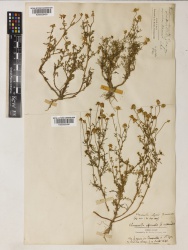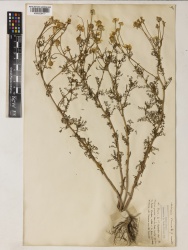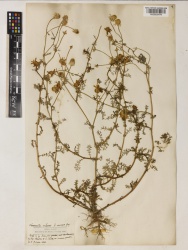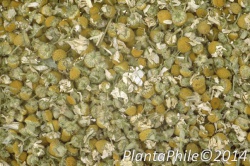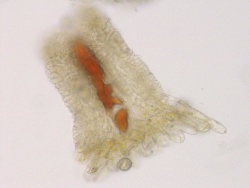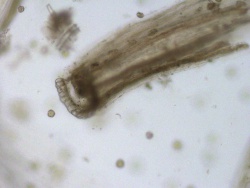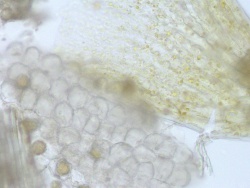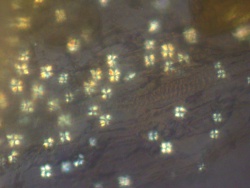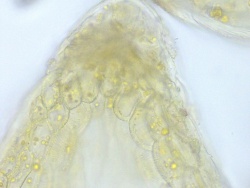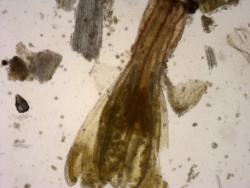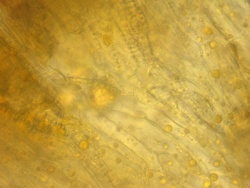Matricaria recutita (flower)
(add Kew voucher specimen reference) |
|||
| (24 intermediate revisions by 4 users not shown) | |||
| Line 1: | Line 1: | ||
| − | {{Botanical | source=Schneider, A. (1921) The Microanalysis of Powdered Vegetable Drugs, 2nd ed. | + | {{DISPLAYTITLE:''Matricaria recutita'' (flower)}} {{askbox|herb=''Matricaria recutita''}} |
| + | =Nomenclature= | ||
| + | {{nomenclature | binomial=Matricaria recutita | ||
| + | |authority=L. | ||
| + | |family=Asteraceae | ||
| + | |scn=chamomile | ||
| + | |syn=''Chamomilla recutita'' (L.) Rauschert; ''Matricaria chamomilla'' L.; ''Matricaria suaveolens'' L. | ||
| + | |aka=German chamomile; Hungarian chamomile; mayweed; sweet false chamomile; true chamomile | ||
| + | |ayurvedic= | ||
| + | |pinyin= | ||
| + | |notes=}} | ||
| + | |||
| + | =Botanical Voucher Specimen= | ||
| + | {{Media3 |cat=Voucher | ||
| + | |||
| + | | companyimage=Kewlogo.gif | ||
| + | | companyURL=http://specimens.kew.org/herbarium/K000928477 | ||
| + | | mainimage=Matricaria recutita Kew barcode=K000928477 513152.jpg | ||
| + | | source=Royal Botanic Gardens, Kew. | ||
| + | |||
| + | | companyimage2=Kewlogo.gif | ||
| + | | companyURL2=http://specimens.kew.org/herbarium/K000928478 | ||
| + | | image2=Matricaria recutita Kew barcode=K000928478 513147.jpg | ||
| + | | source2=Royal Botanic Gardens, Kew. | ||
| + | |||
| + | | companyimage3=Kewlogo.gif | ||
| + | | companyURL3=http://specimens.kew.org/herbarium/K000928480 | ||
| + | | image3=Matricaria recutita Kew barcode=K000928480 513148.jpg | ||
| + | | source3=Royal Botanic Gardens, Kew. | ||
| + | |||
| + | }} | ||
| + | |||
| + | =Organoleptic Characteristics= | ||
| + | {| border=1 | ||
| + | | | ||
| + | {{Organolepsy | source=Steven Yeager, Mountain Rose Herbs | ||
| + | | companyimage=Mrh logo.jpg | ||
| + | | companyURL=http://www.MountainRoseHerbs.com | ||
| + | |description= | ||
| + | '''Flavor:''' Slightly bitter, sweet, aromatic. | ||
| + | |||
| + | '''Aroma:''' Fragrant, aromatic, pleasant. }} | ||
| + | |||
| + | {{Organolepsy | source=Schneider, A. (1921) The Microanalysis of Powdered Vegetable Drugs, 2nd ed. | ||
| + | | description= | ||
| + | '''Flavor:''' Bitter. | ||
| + | |||
| + | '''Aroma:''' Fragrant, chamomile odor. | ||
| + | | }} | ||
| + | |} | ||
| + | |||
| + | =Macroscopic Characteristics= | ||
| + | {| border=1 | ||
| + | | | ||
| + | |||
| + | {{Macroscopy | source=Steven Yeager, Mountain Rose Herbs | ||
| + | | companyimage=Mrh logo.jpg | ||
| + | | companyURL=http://www.MountainRoseHerbs.com | ||
| + | |description=Flowers yellow, white, and some green; receptacle conical, hollow when cut longitudinally; phyllaries with pale dry margins.| }} | ||
| + | |||
| + | {{ Media2 | cat=Macroscopy | ||
| + | | source=PlantaPhile | ||
| + | | mainimage=PlantaPhile - 1162.jpg | ||
| + | | companyimage=PlantaPhile logo.jpg | ||
| + | | companyURL=http://plantaphile.com/ | ||
| + | |||
| + | | source2=PlantaPhile | ||
| + | | image2=PlantaPhile - 2626.jpg | ||
| + | | companyimage2=PlantaPhile logo.jpg | ||
| + | | companyURL2=http://plantaphile.com/ | ||
| + | | }} | ||
| + | |} | ||
| + | |||
| + | |||
| + | =Microscopic Characteristics= | ||
| + | {| border=1 | ||
| + | | | ||
| + | {{Microscopy | source=Schneider, A. (1921) The Microanalysis of Powdered Vegetable Drugs, 2nd ed. | ||
| description=Chamomile (flowering parts) (''Matricaria chamomilla'') L., Compositae. | | description=Chamomile (flowering parts) (''Matricaria chamomilla'') L., Compositae. | ||
| color=Greenish. | | color=Greenish. | ||
| − | |||
| − | |||
| characteristics=Epidermal cells with sinuate vertical walls; abundant collapsed parenchyma tissue; very porous tracheid-like cells. No starch. The pollen grains with prominent conical projections and three pores form the most marked microscopial characteristic of the powder. The glandular trichromes are usually so much collapsed as to be unrecognizable. | | characteristics=Epidermal cells with sinuate vertical walls; abundant collapsed parenchyma tissue; very porous tracheid-like cells. No starch. The pollen grains with prominent conical projections and three pores form the most marked microscopial characteristic of the powder. The glandular trichromes are usually so much collapsed as to be unrecognizable. | ||
| ash=Ash 10 per cent. | | ash=Ash 10 per cent. | ||
| adulterants=Adulterated with flowers of ''Anthemis arvensis'', ''Maruta cotula'', and other related plants. Compare with Roman chamomile. | | adulterants=Adulterated with flowers of ''Anthemis arvensis'', ''Maruta cotula'', and other related plants. Compare with Roman chamomile. | ||
| }} | | }} | ||
| + | {{Microscopy | source=Amy Brush, Traditional Medicinals | ||
| + | | companyimage=TMLogoK832X75.jpg | ||
| + | | companyURL=http://www.traditionalmedicinals.com | ||
| + | | source=Amy Brush, Traditional Medicinals | ||
| + | | description=Epidermis has irregularly sinuous walls, often with palisade parenchmya, stomata deeply sunken surrounded by 6-8 subsidiary cells, various sizes of calcium oxalate cluster crystals abundant. }} | ||
| + | |||
| + | {{Media4 |cat=Microscopy | ||
| + | |companyimage= TMLogoK832X75.jpg | ||
| + | | companyURL= http://www.traditionalmedicinals.com | ||
| + | |mainimage= Chamomile_stigma,_style_and_pollen,_200x.jpg | ||
| + | |caption1= Chamomile papillose stigma, style and pollen grain, glycerine : deionized water, 200x | ||
| + | |source=Amy Brush, Traditional Medicinals | ||
| + | |companyimage2= TMLogoK832X75.jpg | ||
| + | | companyURL2= http://www.traditionalmedicinals.com | ||
| + | |image2= Chamomile_stigma_with_papillae_and_oil,_400x.jpg | ||
| + | |caption2= Chamomile papillose stigma with oil droplets, glycerine : deionized water, 400x | ||
| + | |source2= Amy Brush, Traditional Medicinals | ||
| + | |companyimage3= TMLogoK832X75.jpg | ||
| + | | companyURL3= http://www.traditionalmedicinals.com | ||
| + | |image3= Chamomile_sclerous_ring_on_ovary,_100x.jpg | ||
| + | |caption3= Chamomile sclerous ring at ovary base, glycerine : deionized water,_100x | ||
| + | |source3= Amy Brush, Traditional Medicinals | ||
| + | |companyimage4= TMLogoK832X75.jpg | ||
| + | | companyURL4= http://www.traditionalmedicinals.com | ||
| + | |image4= Chamomile_ovary_base,_400x.jpg | ||
| + | |caption4= Chamomile, close-up of sclerous ring at ovary base and tricolpate pollen grain, glycerine : deionized water, 400x | ||
| + | |source4= Amy Brush, Traditional Medicinals }} | ||
| + | |||
| + | {{Media4 |cat=Microscopy | ||
| + | |companyimage= TMLogoK832X75.jpg | ||
| + | | companyURL= http://www.traditionalmedicinals.com | ||
| + | |mainimage= Chamomile_stigma_with_papillae_and_pollen,_600x.jpg | ||
| + | |caption1= Chamomile papillose stigma with pollen grain, glycerine : deionized water, 600x | ||
| + | |source= Amy Brush, Traditional Medicinals | ||
| + | |companyimage2= TMLogoK832X75.jpg | ||
| + | | companyURL2= http://www.traditionalmedicinals.com | ||
| + | |image2= Chamomile_inner_&_outer_epidermis,_200x.jpg | ||
| + | |caption2= Chamomile inner (lower with pollen) and outer (upper with oil droplets), glycerine : deionized water, 200x6 | ||
| + | |source2= Amy Brush, Traditional Medicinals | ||
| + | |companyimage3= TMLogoK832X75.jpg | ||
| + | | companyURL3= http://www.traditionalmedicinals.com | ||
| + | |image3= chamomile_microrosettes,_600x.jpg | ||
| + | |caption3= Calcium oxalate microrosette crystals in chamomile, glycerine : deionized water, polarized light, 600x | ||
| + | |source3= Amy Brush, Traditional Medicinals | ||
| + | |companyimage4= TMLogoK832X75.jpg | ||
| + | | companyURL4= http://www.traditionalmedicinals.com | ||
| + | |image4= Chamomile_outer_epidermis_with_oil,_400x.jpg | ||
| + | |caption4= Outer epidermis with oil droplets, glycerine : deionized water, 200x | ||
| + | |source4= Amy Brush, Traditional Medicinals }} | ||
| + | |||
| + | {{Media2 |cat=Microscopy | ||
| + | |companyimage= TMLogoK832X75.jpg | ||
| + | | companyURL= http://www.traditionalmedicinals.com | ||
| + | |mainimage= Chamomile_flower,_pollen_tubes_40x.jpg | ||
| + | |caption1= Pollen tubes in chamomile flower, glycerine : deionized water, 40x | ||
| + | |source= Amy Brush, Traditional Medicinals | ||
| + | |companyimage2= TMLogoK832X75.jpg | ||
| + | | companyURL2= http://www.traditionalmedicinals.com | ||
| + | |image2= Chamomile outer epidermis and oil, 400x.jpg | ||
| + | |caption2= Chamomile outer epidermis and oil, glycerine : deionized water, 400x | ||
| + | |source2= Amy Brush, Traditional Medicinals }} | ||
| + | |||
| + | |||
| + | |} | ||
| + | |||
| + | =High Performance Thin Layer Chromatographic Identification= | ||
| + | {{HPTLC | source=HPTLC Association | ||
| + | | companyimage=HPTLC-assoc-Logo-farbig-Text-schwarz-300x47.png | ||
| + | | companyURL=http://www.hptlc-association.org/ | ||
| + | | mainimage=Matricaria recutita flower-UV 366 nm-hptlc-association.png | ||
| + | | caption1=''Matricaria recutita'' HPTLC ID - Anisaldehyde reagent, UV 366 nm | ||
| + | | description=Chamomile (flower) (''Matricaria recutita'') | ||
| + | | image2=Matricaria recutita flower-white RT-hptlc-association.png | ||
| + | | caption2=''Matricaria recutita'' HPTLC ID - Anisaldehyde reagent, white RT | ||
| + | | | ||
| + | | stationaryphase=Stationary phase, i.e. Silica gel 60, F254 | ||
| + | | mobilephase= Ethyl acetate, cyclohexane 1:1 (v/v) | ||
| + | | prep=Sample: Mix 1 g of powdered sample with 10 mL of methanol and sonicate for 10 minutes, then centrifuge or filter the solutions and use the supernatants / filtrates as test solutions. Dissolve 10 µL of the essential oil in 1 mL of toluene. | ||
| + | |||
| + | Derivatization reagent: Anisaldehyde reagent; Preparation: 170 mL of ice-cooled methanol are mixed with 20 mL of acetic acid, 10 mL of sulfuric acid and 1 mL of anisaldehyde; Use: Dip (time 0, speed 5), heat at 100°C for 4 min. | ||
| + | | detection=Saturated chamber; developing distance 70 mm from lower edge; relative humidity 33% | ||
| + | | referencesamples=Reference: Dissolve 1.5 mg of apigenin in 5 mL of methanol. Dissolve 1 mg of parthenolide in 5 mL of methanol. | ||
| + | | | ||
| + | | lanes=Lanes, from left to right (Track, Volume, Sample): | ||
| + | # 1 µL Feverfew flower from Mexico | ||
| + | # 2 µL Feverfew flower from Mexico | ||
| + | # 4 µL Feverfew flower from Mexico | ||
| + | # 3 µL Feverfew flower | ||
| + | # 3.5 µL Feverfew flower | ||
| + | # 4 µL Feverfew flower | ||
| + | # 2 µL Parthenolide | ||
| + | # 2 µL Apigenin | ||
| + | # 1 µL Roman Chamomile flower | ||
| + | # 2 µL Roman Chamomile flower | ||
| + | # 4 µL Roman Chamomile flower | ||
| + | # 1 µL Chamomile flower | ||
| + | # '''2 µL Chamomile flower''' | ||
| + | # 4 µL Chamomile flower | ||
| + | # 1 µL Chamomile flower oil | ||
| + | |||
| + | | notes=''Images presented in this entry are examples and are not intended to be used as basis for setting specifications for quality control purposes.'' | ||
| + | |||
| + | System suitability test (UV 366 nm): Apigenin: blue zone at Rf ~ 0.20; Parthenolide: pink zone at Rf ~ 0.48 | ||
| + | |||
| + | Identification: Compare result with reference images. The fingerprint of the test solution is similar to that of the corresponding botanical reference sample. Additional weak zones may be present. Under UV 366 nm the chromatogram of the test solution shows a dark blue zone at Rf ~ 0.46 (blue arrow; not visible under white light) a brown zone between Rf ~ 0.30 and 0.40 and another weak blue zone at Rf ~ 0.30. At the position of apigenin reference substance (Rf ~ 0.20) two brown zones are present (violet under white light). | ||
| + | |||
| + | Test for adulteration: Under UV 366 nm no pink zone (violet zone under white RT) at Rf ~ 0.48 corresponding to reference substance parthenolide is seen and there are no brown zones at the position of apigenin at Rf ~ 0.20 (green arrows, Feverfew flower). | ||
| + | Under UV 366 nm there are no intense red zones (violet zones under white RT) between Rf ~ 0.20 and 0.30. No blue zone is seen at the position of parthenolide (orange arrows; Feverfew flower from Mexico). Under UV 366 nm no blue zone at the position of apigenin (Rf ~ 0.20) and no orange zone at Rf ~ 0.70 (purple under white light) is seen (yellow arrows; Roman Chamomile flower). Chamomile flower oil does not show any zones below Rf ~ 0.60. | ||
| + | |||
| + | | }} | ||
| + | |||
| + | =Supplementary Information= | ||
| + | |||
| + | =Sources= | ||
| + | |||
| + | <references /> | ||
Latest revision as of 15:07, 26 May 2015
Contents |
Nomenclature
Matricaria recutita L. Asteraceae
Syn. Chamomilla recutita (L.) Rauschert; Matricaria chamomilla L.; Matricaria suaveolens L.
Standardized common name (English): chamomile
Botanical Voucher Specimen
 |
 |
 |
|
|
|
|
Organoleptic Characteristics
|
Macroscopic Characteristics
|
Microscopic Characteristics
|
High Performance Thin Layer Chromatographic Identification
|
Chamomile (flower) (Matricaria recutita) Lane Assignments Lanes, from left to right (Track, Volume, Sample):
Reference Sample(s) Reference: Dissolve 1.5 mg of apigenin in 5 mL of methanol. Dissolve 1 mg of parthenolide in 5 mL of methanol. Stationary Phase Stationary phase, i.e. Silica gel 60, F254 Mobile Phase Ethyl acetate, cyclohexane 1:1 (v/v) Sample Preparation Method Sample: Mix 1 g of powdered sample with 10 mL of methanol and sonicate for 10 minutes, then centrifuge or filter the solutions and use the supernatants / filtrates as test solutions. Dissolve 10 µL of the essential oil in 1 mL of toluene. Derivatization reagent: Anisaldehyde reagent; Preparation: 170 mL of ice-cooled methanol are mixed with 20 mL of acetic acid, 10 mL of sulfuric acid and 1 mL of anisaldehyde; Use: Dip (time 0, speed 5), heat at 100°C for 4 min. Detection Method Saturated chamber; developing distance 70 mm from lower edge; relative humidity 33% Other Notes Images presented in this entry are examples and are not intended to be used as basis for setting specifications for quality control purposes. System suitability test (UV 366 nm): Apigenin: blue zone at Rf ~ 0.20; Parthenolide: pink zone at Rf ~ 0.48 Identification: Compare result with reference images. The fingerprint of the test solution is similar to that of the corresponding botanical reference sample. Additional weak zones may be present. Under UV 366 nm the chromatogram of the test solution shows a dark blue zone at Rf ~ 0.46 (blue arrow; not visible under white light) a brown zone between Rf ~ 0.30 and 0.40 and another weak blue zone at Rf ~ 0.30. At the position of apigenin reference substance (Rf ~ 0.20) two brown zones are present (violet under white light). Test for adulteration: Under UV 366 nm no pink zone (violet zone under white RT) at Rf ~ 0.48 corresponding to reference substance parthenolide is seen and there are no brown zones at the position of apigenin at Rf ~ 0.20 (green arrows, Feverfew flower). Under UV 366 nm there are no intense red zones (violet zones under white RT) between Rf ~ 0.20 and 0.30. No blue zone is seen at the position of parthenolide (orange arrows; Feverfew flower from Mexico). Under UV 366 nm no blue zone at the position of apigenin (Rf ~ 0.20) and no orange zone at Rf ~ 0.70 (purple under white light) is seen (yellow arrows; Roman Chamomile flower). Chamomile flower oil does not show any zones below Rf ~ 0.60. Source: HPTLC Association [21] |
Supplementary Information
Sources
- ↑ Royal Botanic Gardens, Kew. http://specimens.kew.org/herbarium/K000928477
- ↑ Royal Botanic Gardens, Kew. http://specimens.kew.org/herbarium/K000928478
- ↑ Royal Botanic Gardens, Kew. http://specimens.kew.org/herbarium/K000928480
- ↑ Steven Yeager, Mountain Rose Herbs http://www.MountainRoseHerbs.com
- ↑ Schneider, A. (1921) The Microanalysis of Powdered Vegetable Drugs, 2nd ed.
- ↑ Steven Yeager, Mountain Rose Herbs http://www.MountainRoseHerbs.com
- ↑ PlantaPhile http://plantaphile.com/
- ↑ PlantaPhile http://plantaphile.com/
- ↑ Schneider, A. (1921) The Microanalysis of Powdered Vegetable Drugs, 2nd ed.
- ↑ Amy Brush, Traditional Medicinals http://www.traditionalmedicinals.com
- ↑ Amy Brush, Traditional Medicinals http://www.traditionalmedicinals.com
- ↑ Amy Brush, Traditional Medicinals http://www.traditionalmedicinals.com
- ↑ Amy Brush, Traditional Medicinals http://www.traditionalmedicinals.com
- ↑ Amy Brush, Traditional Medicinals http://www.traditionalmedicinals.com
- ↑ Amy Brush, Traditional Medicinals http://www.traditionalmedicinals.com
- ↑ Amy Brush, Traditional Medicinals http://www.traditionalmedicinals.com
- ↑ Amy Brush, Traditional Medicinals http://www.traditionalmedicinals.com
- ↑ Amy Brush, Traditional Medicinals http://www.traditionalmedicinals.com
- ↑ Amy Brush, Traditional Medicinals http://www.traditionalmedicinals.com
- ↑ Amy Brush, Traditional Medicinals http://www.traditionalmedicinals.com
- ↑ HPTLC Association http://www.hptlc-association.org/
